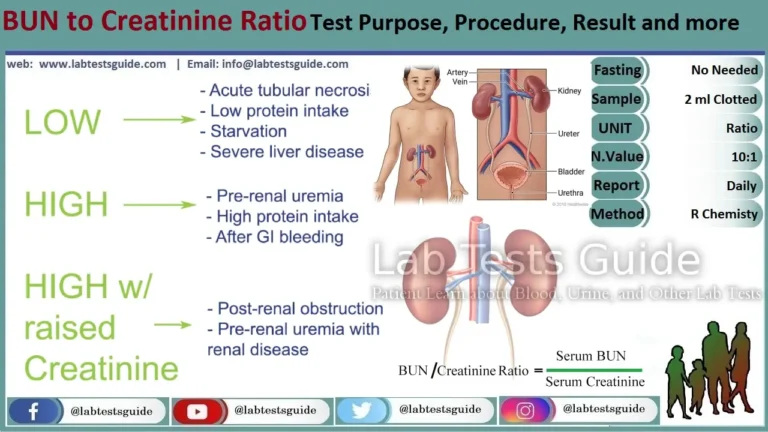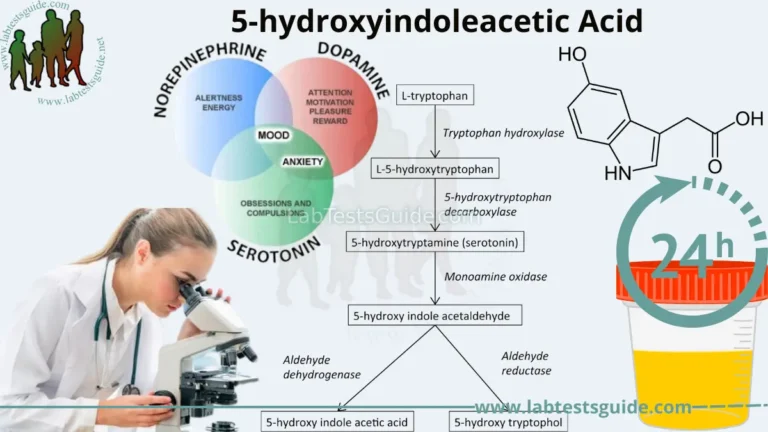Urine Dipstick Tests are a group of laboratory tests that analyze the chemical composition of a person’s urine. Urine is a waste product produced by the kidneys that contains various substances, including water, electrolytes, waste products, and other organic and inorganic compounds. Urine chemical tests are commonly used to diagnose and monitor various medical conditions, such as kidney disease, diabetes, urinary tract infections, and liver problems.

Defination of Urine Dipstick Tests:
A urine Dipstick tests or chemical examination test is a simple and quick diagnostic test that checks for various substances in urine, such as glucose, protein, ketones, pH, blood, and white blood cells. It is a common test used in medical settings to screen for conditions such as urinary tract infections, diabetes, kidney disease, and liver problems.
Type of urine samples:
- Random sample:
This is a diluted urine sample and may give an inaccurate interpretation of patient health. But is best to do microscopy to evaluate WBC or RBC. - First Morning sample:
This is the best sample for microscopy and urine analysis. This is the concentrated urine because of urine remained throughout the night in the urinary bladder. This will contains an increased concentration of analytes and cellular elements. Urine must have remained in the bladder for 8 hours is considered as the first-morning sample. - Urine for sugar (Postprandial 2 hours):
Postprandial 2 hours sample collected after 2 hours of high carbohydrate diet. - Midstream clean catch urine:
This sample is needed for the culture and sensitivity of urinary infection. The patient is advised to clean the urethra, then discard the first few mL of urine. Now midstream of the urine is collected in the sterile container. - 24 Hours of a urine sample
- In this case, discard the first urine and note the time.
- Now collect urine in the container for 24 hours and put the last sample in the container.
- Refrigerate the sample.
- This 24 hours samples are needed for measuring urea, creatinine, sodium, potassium, glucose, and catecholamines.
- Suprapubic collection of the urine sample:
This is done in the patients who cannot be catheterized and the sample is needed for culture. This sample is collected by the needle. - Catheter collection of urine:
This is done by patients who are bedridden and can not urinate. - Pediatric urine sample:
In infants, special collection bags are made adherent around the urethra. Then urine is transferred to a container.
Urine Dipstick Tests ( Chemical test ):
Here is a list of the chemical examination of urine:
- Protein: Protein is not normally present in urine, but small amounts may be found. Excessive protein in urine can indicate kidney damage or disease.
- Glucose: Glucose is not normally present in urine, but may be found in individuals with high blood sugar levels, such as those with diabetes.
- Ketones: Ketones are produced by the body when it breaks down fat for energy instead of glucose. Ketones in urine may indicate uncontrolled diabetes, a low-carbohydrate diet, or other metabolic conditions.
- Bilirubin: Bilirubin is a waste product produced when red blood cells break down. Elevated levels of bilirubin in urine may indicate liver disease or other conditions that affect the liver.
- Urobilinogen: Urobilinogen is a byproduct of bilirubin metabolism. Elevated levels may indicate liver disease or other conditions that affect the liver.
- Blood : The presence of hemoglobin in urine may indicate the breakdown of red blood cells or other health conditions.
- Nitrite : Nitrite is produced by certain bacteria that cause urinary tract infections. The presence of nitrite in urine may indicate a UTI.
- Leukocyte esterase: Leukocyte esterase is an enzyme produced by white blood cells. Its presence in urine may indicate a UTI or other infection.
- pH: The pH of urine is a measure of its acidity or alkalinity. Normal urine pH is typically between 4.5 and 8.0.
- Specific gravity: Specific gravity measures the concentration of solutes in urine, and a normal range is between 1.005 and 1.030.
Interpreting the Results of Urine Dipstick Tests:
Urine Dipstick tests are used to evaluate various substances in urine to determine the overall health of a person. The results of these tests can indicate potential health issues or identify abnormalities that may require further testing or treatment. Here are some common urine chemical tests and their interpretation:
- pH Test: The pH test measures the acidity or alkalinity of urine. The normal range is 4.6 to 8.0. A high pH level may indicate a urinary tract infection, while a low pH level may indicate kidney stones.
- Protein Test: The protein test measures the amount of protein in urine. Normally, there should be very little protein in urine. A high protein level may indicate kidney disease, preeclampsia in pregnant women, or a urinary tract infection.
- Glucose Test: The glucose test measures the amount of sugar in urine. Normally, there should be very little sugar in urine. A high glucose level may indicate diabetes.
- Ketone Test: The ketone test measures the amount of ketones in urine. Ketones are produced when the body breaks down fat for energy instead of glucose. A high ketone level may indicate uncontrolled diabetes, starvation, or a low-carbohydrate diet.
- Bilirubin Test: The bilirubin test measures the amount of bilirubin in urine. Bilirubin is a waste product produced by the liver. A high bilirubin level may indicate liver disease or damage.
- Nitrite Test: The nitrite test measures the presence of nitrites in urine. Nitrites are produced by bacteria that cause urinary tract infections. A positive nitrite test may indicate a urinary tract infection.
- Leukocyte Esterase Test: The leukocyte esterase test measures the presence of white blood cells in urine. A positive leukocyte esterase test may indicate a urinary tract infection.
Normal Urine Findings:
Here is a table of normal urine findings:
| Characteristic | Normal |
|---|---|
| Color | Pale or yellow |
| Appearance | Clear |
| Odor | Mildly aromatic |
| Volume | 1200 to 2000 ml/24 hours |
| pH | 5 to 7 |
| Specific gravity | 1.001 to 1.035 |
| Cast (hyaline) | 0 to 5 / HPF |
| Red blood cells | ≤ 3 / HPF |
| Blood | Negative Rarely 2 to 3 RBCs/HPF |
| White blood cells | ≤2 to 5 HPF Male = 1 to 2 /HPF Female = 0 to 5 /HPF |
| Squamous epithelial cells | ≤ 15 to 20 / HPF |
| Yeast | Negative |
| Bacteria | Negative |
| Protein | Negative |
| Glucose | Random sample = Negative 24 hours sample = 1 to 15 mg/dL |
| Ketones | Urine = Negative |
| Bilirubin | Negative (o to 0.02 mg/dL) |
| Urobilinogen | Negative Random sample= <1 mg/dL 2-hour sample = <1 mg /2 hours 24- hours sample = 0.5 to 4.0 mg/dL |
| Nitrite | Negative |
| Albumin | 10 to 100 mg /24 hours |
| Protein | Quantitative = negative Urine 24 hours sample: Adult male = 1 to 14 mg/dL Adult female = 3 to 10 mg/dL Child <10 years = 1 to 10 mg/dL |
| Calcium | Normal diet = 100 to 300 mg/24 hours Low-calcium diet = 50 to 150 mg/24 hours(Another source = 0.3 g/24 hours) |
| Sodium chloride | average 10 g /24 hours Patient with moderate to severe salt depletion = <10 mmol/L or <20 mmol/L /24 hours(Another source = 15.0 g/24 hours) |
| Sodium | Adult = 40 to 220 meq/24 hoursChild = 41 to 115 meq/24 hours |
| Potassium | Adult = 25 to 125 meq/ 24 hours Child = 10 to 60 meq/24 hours(Another source = 3.3 g/24 hours) |
| Magnesium | 75 to 150 mg/24 hours(Another source = 0.1 g/24 hours) |
| Bicarbonate | Negative |
| Creatinine | Male = 20 to 28 mg/Kg/24 hours Female = 15 to 21 mg/Kg/24 hours(Another source = 1.5 g/24 hours) |
| Urea nitrogen | 5 to 15 g/24 hours |
| Nitrogen | 7 to 20 g/24 hours |
| Urea | 10 to 35 g/24 hours(Another source = 25.0 to 35.0 g/24 hours) |
| Uric acid | With normal diet = 250 to 750 mg/24 hours With purine-free diet = <400 mg/24 hours With high-purine diet = <1000 mg/24 hours(Another source = 0.4 to 1.0 g/24 hours) |
| Urobilinogen | 0.2 to 4.0 mg/24 hours |
| Chloride | Adult = 110 to 250 meq/24 hours Child: <6 years = 15 to 40 meq/24 hours Child: 10 to 16 years = 64 to 176 meq/24 hours |
Limitations of Urine Dipstick Tests:
While urine dipstick tests are a quick and convenient way to evaluate various substances in urine, they do have some limitations. Here are some of the limitations of urine dipstick tests:
- Limited sensitivity: Urine dipstick tests may not detect all levels of certain substances, leading to false negatives. For example, the protein dipstick test may not detect low levels of protein in urine.
- Limited specificity: Urine dipstick tests may detect substances that are not relevant to a particular health condition, leading to false positives. For example, the protein dipstick test may detect protein in urine due to dehydration or exercise, not just kidney disease.
- Interference: Certain medications or supplements may interfere with urine dipstick test results. For example, vitamin C supplements may cause a false negative on the glucose dipstick test.
- Timing: The accuracy of urine dipstick tests can be affected by the timing of urine collection. For example, a urine sample that has been sitting for too long may give inaccurate results.
- Limited information: Urine dipstick tests only evaluate a limited number of substances in urine. They do not provide information about the overall health of the kidneys or other organs.
- User error: Improper use of urine dipstick tests can lead to inaccurate results. For example, failing to properly dip the test strip into the urine sample can result in a false negative.
It is important to keep these limitations in mind when interpreting urine dipstick test results. If you have any concerns or questions about your urine dipstick test results, it is recommended to consult with your healthcare provider.
Possible References Used





